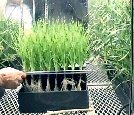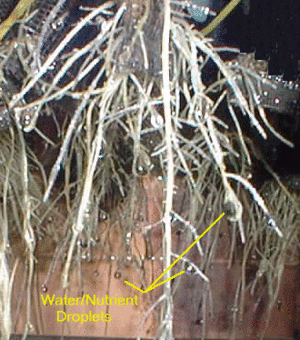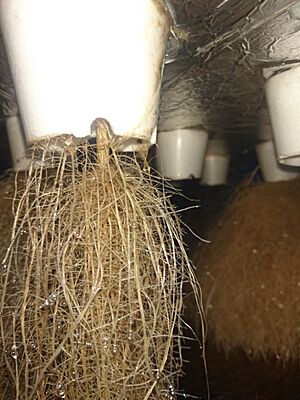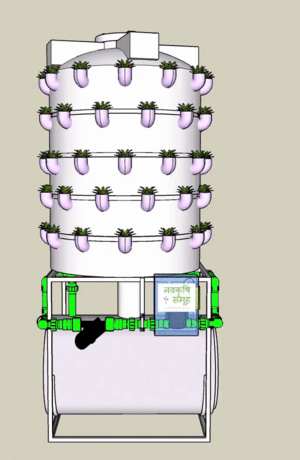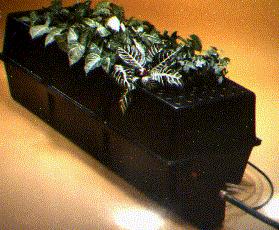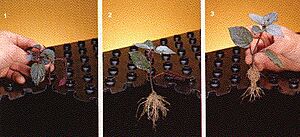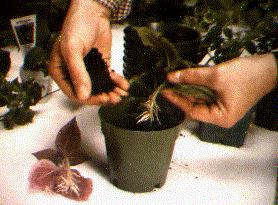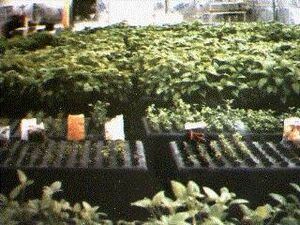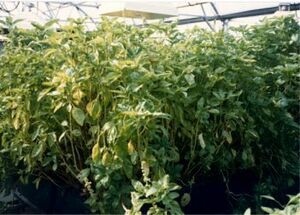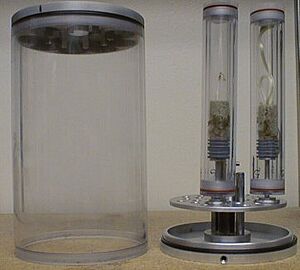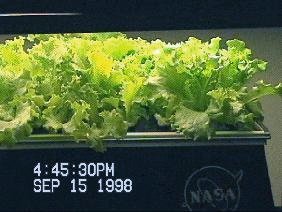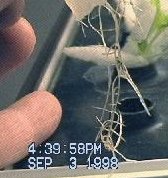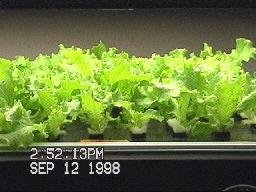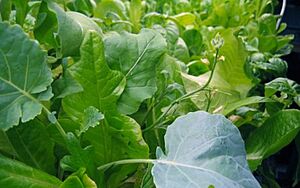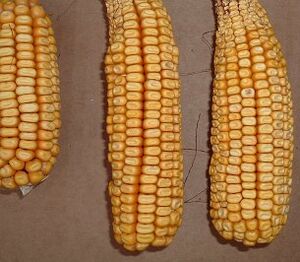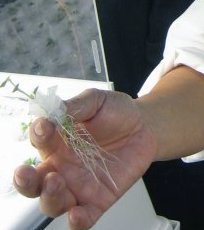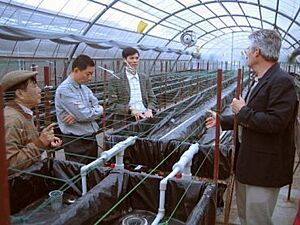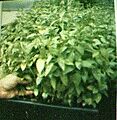Aeroponics facts for kids
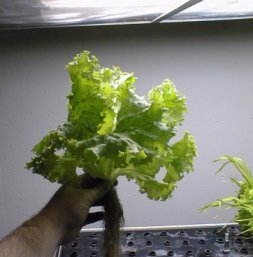
Aeroponics is a special way to grow plants without using soil or any other growing material. Instead, the plants hang in the air, and their roots are sprayed with a fine mist of water that has all the nutrients they need. The word "aeroponic" comes from old Greek words: aer meaning "air" and ponos meaning "labor" or "work." It's a type of hydroponics, which means growing plants in water.
Contents
How Aeroponics Works
The main idea behind aeroponics is simple. Plants are held up in a closed or partly closed space. Their roots and lower stems hang down and are sprayed with a nutrient-rich water solution. This solution is turned into a fine mist or spray. The top part of the plant, like the leaves and the "crown" (the top leafy part), stays above the growing area.
A special structure holds the plant so its roots are separate. Often, soft foam is gently squeezed around the lower stem and placed into an opening in the aeroponic chamber. For bigger plants, a trellis (a support frame) is used to hold up the weight of the plant and its fruits.
The goal is to keep the growing area free from pests and diseases. This helps plants grow faster and healthier than those grown in soil. Even though most aeroponic systems aren't completely sealed, they help control the environment. This controlled setting helps plants grow, flower, and produce fruit better.
Sometimes, aeroponics is used with regular hydroponics. This is like a backup plan. If the aeroponic system has a problem, the hydroponic part can still give the plants water and nutrients. This helps save the plants.
There's also "high-pressure aeroponics." This method uses a strong pump to spray nutrients onto the roots. The mist droplets are very tiny, about 20 to 50 micrometers in size.
Benefits of Aeroponics
More Air for Roots
Aeroponics gives plant roots lots of air. This helps them grow really well. The parts that hold the plants must be very clean to prevent diseases. A good aeroponic system lets as much air as possible get to the plant by not touching too much of it. This helps the roots grow freely and get enough air and clean water.
Oxygen for Healthy Roots
Having enough oxygen in the root area is super important for plants to grow strong. In aeroponics, plants grow in air with tiny water droplets. This means their roots get plenty of oxygen, water, and nutrients. Almost any plant can grow well and become mature this way.
Many growers like aeroponic systems more than other hydroponic methods. This is because the nutrient solution gets more air, which gives the roots more oxygen. This helps plants grow faster and stops harmful pathogens (germs) from forming.
Clean air is key in aeroponics. Plants need free access to air to grow naturally. If the support structure squeezes the plant, it can hurt the plant and make it sick.
Scientists have used aeroponics to study how different gases in the root zone affect plants. They found that oxygen is very important for roots to form. Roots grew longer and more numerous in the misted areas compared to areas that were submerged in water or not misted.
CO2 for Photosynthesis
Aeroponics also helps control the amount of CO2 (carbon dioxide) in the air around the plants. CO2 is important because plants use it for photosynthesis, which is how they make their food.
Using artificial lights with aeroponics can make plants grow even faster and more reliably than using sunlight.
Growing Without Disease
Aeroponics is great for stopping diseases from spreading. Since plants are separate and not in shared soil, it's harder for diseases to jump from one plant to another. In regular farming, soil often needs to be cleaned or replaced after each crop to get rid of diseases.
A big benefit of aeroponics is that if one plant gets sick, you can quickly take it out without bothering or infecting the other plants. This is because each plant is separate.
Because aeroponics creates a disease-free environment, you can grow many more plants in a smaller space compared to traditional farming or other hydroponic methods. Commercial aeroponic systems are built to let the roots grow big.
Scientists also use aeroponics to quickly check if certain plant types can resist diseases that affect roots. Since there's no soil, it's easier to study these infections without problems.
Misting Water and Nutrients
Aeroponic systems use special sprayers or misters to create a fine mist of nutrient solution for the roots. These systems are usually closed, meaning the air and water are controlled to keep the plants healthy.
The size of the water droplets is very important for root growth. In big farms, a 360-degree spray is used to cover large root areas.
A different misting method called fogponics uses special foggers to create a very fine mist.
If the water droplets are too big, the roots might not get enough oxygen. If they are too fine, the roots might grow too many tiny hairs but not enough strong side roots.
Advanced Materials for Misters
NASA has helped develop new materials to make aeroponic systems more reliable and easier to maintain. They found that a high-pressure mist with tiny droplets (5 to 50 micrometers) is best for long-term aeroponic growth.
For plants to grow well over a long time, the mist system needs enough pressure to reach all parts of the dense roots. It's important that the mist droplets are always the right size. If the mist heads get clogged with minerals, the spray can get worse, making the environment unbalanced for the plants.
To fix this, new lightweight plastic materials have been made. These materials stop minerals from building up in the misting jets. This helps the system work well for a long time.
How Plants Take Up Nutrients
Aeroponics lets scientists measure how much water and nutrients plants take up over time. This is because the system can be turned on and off, and the plants are separate. Scientists can measure the nutrients going in and coming out to figure out how much the plant used.
When the mist is sprayed at high pressures (over 65 pounds per square inch), plants can absorb nutrients even better. This means you need to use less concentrated nutrient solution to avoid burning the leaves and roots.
For best results, the spray cycles should be very short. Roots should stay a little damp but never too dry. A common cycle is less than 2 seconds of spraying followed by about 1.5 to 2 minutes of pause, all the time.
A Tool for Research
Aeroponics quickly became a useful tool for scientists. It lets them look at growing roots without disturbing them. This new technology opened up many more ways to do experiments.
Aeroponics is great for studying how plants handle water stress (too much or too little water). Scientists can easily control the water levels around the roots.
It's also good for studying how roots are shaped. Since there's no soil, scientists can easily see the whole root system without damaging it. Roots grown in aeroponics often look more natural than those grown in hydroponics.
Aeroponics Terms
- Aeroponic cultivation: Growing plants in an air environment, letting them grow naturally.
- Aeroponic growth: The process of plants growing in an air environment.
- An aeroponic system: All the equipment and parts used to help plants grow in air.
- An aeroponic greenhouse: A special building with glass or plastic, set up to grow plants in an air/mist environment.
- Aeroponic conditions: The specific environmental settings needed for plants to grow in air, made just right for each plant type.
- Aeroponic roots: The roots that grow when plants are cultivated in an air environment.
Types of Aeroponics Systems
Low-Pressure Systems
In most low-pressure aeroponic gardens, plant roots hang above a tank of nutrient solution or inside a channel connected to it. A small pump sprays the nutrient solution, and any extra drips back into the tank. However, as plants get bigger, some parts of their roots might dry out, which means they don't get enough nutrients. These systems usually don't have ways to clean the nutrient solution or remove dirt and harmful germs. Because they are cheaper, these systems are often used for small home growing or to show how aeroponics works.
High-Pressure Systems
High-pressure aeroponic systems use strong pumps to create a fine mist. These are often used for growing valuable crops or special plants. The benefits of this method can make up for the higher cost to set them up.
High-pressure aeroponic systems use advanced technology to clean air and water, sterilize nutrients, and deliver pressurized nutrients. They also use special lightweight plastics. These features make the aeroponic setup work better.
Commercial Systems
Commercial aeroponic systems combine high-pressure equipment with biological systems. These systems have extra features to help plants live longer and crops grow to maturity.
These big systems include things like ways to control waste water, prevent diseases, resist germs, precisely time and pressurize nutrient solutions, and use sensors for heating and cooling. They also have special lights, safety sensors, and features that make them easy to use and reliable for a long time.
Commercial aeroponic systems are mainly used for growing high-value crops. They allow many harvests throughout the year on a large scale. The most advanced systems even collect data, monitor plants, analyze information, and connect to the internet to improve how they work.
History of Aeroponics
In 1911, a scientist named V.M. Artsikhovski wrote about "Air Plant Cultures." He showed how to study plant roots by spraying different things in the air around them. This is what we now call aeroponics. He built the first aeroponic systems and showed they worked for growing plants.
In 1942, W. Carter did early research on air culture growing. He described a way to grow plants in water vapor to make it easier to look at their roots. Since 2006, aeroponics has been used a lot in farming around the world.
In 1957, F. W. Went came up with the word "aeroponics." He grew coffee plants and tomatoes with their roots hanging in the air, feeding them with a nutrient mist.
The Genesis Machine, 1983
The first aeroponic device sold to the public was made by GTi in 1983. It was called the Genesis Machine, inspired by a science fiction movie. It was sold as the "Genesis Rooting System."
This machine used a computer chip to control a high-pressure spray of nutrient solution inside an aeroponic chamber. The Genesis Machine just needed to be plugged into a water faucet and an electrical outlet to work.
Aeroponic Cloning
Aeroponics changed how plants are cloned (making new plants from cuttings). It made it much easier to clone many plants that were hard or impossible to grow this way before. Even delicate plants like hardwoods and cacti, which often got sick when cloned, can now be grown successfully in aeroponic systems.
Cloning works well in aeroponics because the roots get a lot of air, which helps them grow tiny root hairs. Also, the roots get plenty of nutrients, and there's no soil to cause diseases.
Aeroponics is very important for cloning plants that are hard to reproduce, plants used for medicine, plants that are in high demand, and for creating new types of plants.
It's also better than using overhead misters, which waste a lot of water and can be messy. Aeroponics helps roots grow faster and cleaner in a sterile, nutrient-rich, oxygen-filled, and moist environment.
Air-Rooted Transplants
Aeroponics has made big steps in plant tissue culture technology. It allows faster cloning and reduces the hard work of traditional methods. One great benefit is that you can plant air-rooted plants directly into soil. Normally, plants from tissue culture have to be planted in special sterile soil first, which takes a lot of work and can lead to disease.
With aeroponics, growers can clone plants and put them right into the field soil. Aeroponic roots are stronger and less likely to wilt or suffer from transplant shock compared to plants grown with other methods. Air-rooted plants are also healthier and less likely to get sick. However, it's important to keep the root chamber's humidity below a certain level to prevent pests and bacteria.
GTi's work in creating an all-plastic aeroponic system controlled by a computer chip started a new era for plants. They could grow naturally without soil or traditional hydroponics. GTi even got a patent for their system in 1985. Aeroponics saves time and money, and its use in farming is still growing in the 21st century.
Genesis Growing System, 1985
In 1985, GTi released their second generation of aeroponics equipment, called the "Genesis Growing System." This new system was a big step forward because it was a "closed-loop" system. This means it recycled the used nutrient solution, and a computer controlled everything precisely. With this system, aeroponics could also be used for growing plants from seeds, making it the first system that could grow plants from seed to harvest.
Many of these early aeroponic systems, both open and closed-loop, are still working well today.
Commercial Use
Aeroponics moved from science labs to commercial farms. In 1966, Bruce Briggs, a leader in commercial aeroponics, successfully grew roots on hardwood cuttings using air-rooting. He found that these air-rooted cuttings were stronger than those grown in soil. He also saw that air-rooted trees could be planted in soil without getting transplant shock, which often happens with hydroponic plants.
In 1983, Richard Stoner got a patent for a computer system that delivered tap water and nutrients into a closed plastic aeroponic chamber. Stoner then started several companies to research and improve aeroponic equipment for commercial farming.
Stoner's company, Genesis Technology Inc., was a pioneer in making and selling large closed-loop aeroponic systems for growing crops in greenhouses.
In the 1990s, a company called General Hydroponics [Europe] tried to bring aeroponics to home growers. They introduced the Aerogarden system. Even though it made droplets instead of a fine mist, it created interest in aeroponic growing for hobbies.
Aeroponically Grown Food
In 1986, Stoner achieved a big success by being the first person to sell fresh food grown with aeroponics to a national grocery store chain. He was even interviewed on the radio, where he talked about how important aeroponics is for saving water in farming and even for space travel.
Aeroponics in Space
Plants in Space
Plants first went into space in 1960 on two missions: Sputnik 4 and Discoverer 17. Sputnik 4 carried seeds of wheat, pea, maize, and other plants. Discoverer 17 carried tiny green algae cells.
After these first tries, more plant experiments happened on many space missions. Early research showed how low gravity affected how roots and shoots grew. Later research looked at how low gravity affected plants at different levels, from the whole plant down to tiny cells. Some plants grew less in low gravity, while others, like lettuce on the Cosmos mission, grew more. How plants took up minerals in space was also different.
Natural Disease Control in Space
In 1996, NASA funded Richard Stoner's research on natural ways to control plant diseases. The goal was to find a natural liquid solution for closed hydroponic systems that could stop plant diseases and increase harvests without using harmful chemicals. By 1997, NASA did experiments with Stoner's solution. They used small growth chambers on the Mir space station, at the Kennedy Space Center, and at Colorado State University. They found that Stoner's solution helped seeds sprout better, grow more, and activated the plants' natural ways to fight diseases.
Even though it was first made for NASA, this natural disease control can also be used by farmers on Earth.
To make hydroponic and aeroponic systems stronger against plant diseases and use fewer chemicals, NASA is adding natural controls into their designs. The Advanced Plant Habitat (APA) on the International Space Station (ISS) since 2018 is an example. It has over 180 sensors to help plants grow well and stay healthy, reducing the need for chemical controls. These sensors check things like light, temperature, CO2 levels, humidity, and water.
These environmental controls help stop plant diseases in two ways. First, they keep the environment just right to prevent diseases, fungi, and pests from growing. Second, they create conditions that help the plant's own natural defenses work better.
Aeroponics for Earth and Space
In 1998, NASA gave Stoner money to create a high-performance aeroponic system for both Earth and space. His research showed that lettuce plants grew much faster in aeroponic systems than with other methods. NASA later used many of the aeroponic improvements Stoner developed.
Scientists have been working to find ways to grow plants quickly in different gravity levels. In space, it's hard to deliver water and nutrients efficiently and to get rid of waste. Growing food in space also means managing water carefully, using as little as possible, and making systems lightweight. On the Moon and Mars, there will be less gravity, which affects how liquids move. So, making good nutrient delivery systems is a big focus.
Aeroponic systems use fine sprays to deliver nutrients. This means they use very little water, give roots lots of oxygen, and help plants grow excellently. Aeroponics doesn't need soil, which reduces waste and makes planting and harvesting simpler. It also makes it easier to automate things and removes a way for diseases to spread. These benefits show how useful aeroponics is for growing food in space.
NASA Inflatable Aeroponics
In 1999, NASA funded the creation of a lightweight, inflatable aeroponic system (AIS) for growing food in space and on Earth. The AIS is a self-contained system that delivers nutrients and mist to plant roots. Its inflatable design makes it light and allows it to be deflated for easy transport and storage. This is an improvement over older, rigid systems that were more expensive to build and move.
On Earth, the cost of materials and shipping can make aeroponic systems expensive for commercial growers. These problems are even bigger when sending things to space because of the weight limits.
To solve this, NASA has developed special materials that can handle the harsh space environment for inflatable habitats. These materials are being used in expandable habitats by companies like Bigelow Aerospace. Tests in space have shown that these inflatable structures can work well.
Benefits of Aeroponics for Earth and Space
Aeroponics has many features that make it a very effective and efficient way to grow plants.
Less Nutrient Solution Used
Plants grown with aeroponics spend almost all their time (99.98%) in the air. They are only in direct contact with the nutrient mist for a tiny amount of time (0.02%). This small contact with water allows the roots to get oxygen very well. The mist also helps oxygenate the roots. Aeroponics uses much less nutrient solution than other methods, like Nutrient Film Technique (NFT).
Using less nutrient solution means less water and fewer nutrients are needed overall for the plants to grow.
This reduced water use is especially important for space missions. It makes the system lighter and reduces the amount of waste water that needs to be treated for reuse.
Because aeroponics uses small amounts of solution and the roots are only briefly exposed to the mist, there is less root-to-root contact. This helps stop diseases from spreading among plants.
More Control Over Plant Environment
Aeroponics gives you more control over the environment around the roots compared to other growing systems. In aeroponics, the plant roots are not always surrounded by any growing material.
Better Nutrient Feeding
Aeroponics lets you give different nutrient solutions to the roots without having to clean out old solutions or materials. This high level of control is great for studying how different nutrients affect specific plants. Aeroponics also allows for a wider range of growing conditions. For example, you can precisely adjust how often and how long the nutrient sprays happen to meet a plant's exact needs. This means the top part of the plant can have a different environment than its roots.
Easier to Use
Aeroponic systems are designed to make handling plants easy. Each plant is separate and hangs in the air, not stuck in any material. This makes harvesting each plant simple. If a plant gets infected, it's easy to remove it without pulling up or contaminating other plants nearby.
More Cost-Effective
Aeroponic systems can save money compared to other systems. They use less water and fewer nutrients, as mentioned before. Also, they don't need soil or many moving parts, which helps reduce costs.
Using Seed Stocks
Aeroponics helps reduce the negative effects of germs in seed stocks. Since plants are separate and don't share a growing material, this helps. Also, aeroponics provides a closed and controlled environment, making it perfect for growing germ-free seed stocks. The closed growing chamber and the separation of plants help prevent new contamination from outside germs and stop any existing germs from spreading.
Aeroponics Today
Aeroponics is a big step forward in helping plants grow. It offers gentle plant support, efficient seed sprouting, precise environmental control, and unlimited growth. Compared to older farming methods like hydroponics and drip irrigation, aeroponics brings important improvements to growing plants.
Modern Aeroponics
Modern aeroponic techniques have been studied a lot at NASA's BioServe Space Technologies in Colorado. This research center works on developing and selling aeroponic systems. Scientists at Ames Research Center have also researched closed-loop systems, looking for ways to grow food crops in low-gravity for future space colonization efforts.
In 2000, Stoner received a patent for his natural disease control technology. This allows plants to be grown in aeroponic systems without pesticides.
A big moment for aeroponics happened in 2004 when Ed Harwood, who started AeroFarms, invented a new aeroponic system that uses a special cloth to grow lettuce. AeroFarms, using Harwood's patented technology, now runs the world's largest indoor vertical farm in Newark, New Jersey. This farm uses aeroponics to grow and deliver up to two million pounds of pesticide-free leafy greens every year.
Aeroponic Bio-Pharming
Aeroponic bio-pharming is a new way to grow medicines inside plants. This technology keeps everything contained, so waste products from these special crops stay within the closed system. In 2005, Dr. Neil Reese grew genetically modified corn using aeroponics for research.
Dr. Reese felt it was a big achievement to grow corn in an aeroponic system for making biomass (plant material). Previous attempts to grow different types of corn using hydroponics had not worked.
Using advanced aeroponics, Dr. Reese was able to harvest mature ears of genetically modified corn. He also successfully contained the corn pollen and used water, stopping them from getting into the environment. This ensures that the surrounding area stays free from GMO contamination.
Dr. Reese believes that aeroponics can make bio-pharming affordable, making it a promising way to produce medicines.
Large-Scale Use of Aeroponics
In 2006, the Institute of Biotechnology in Vietnam started a special program on aeroponics with Stoner. The Agrobiotech Research Center is using aeroponic labs to improve Vietnam's potato production for certified seed potatoes.
This is very important because it's the first time a country has focused on aeroponics to boost its farming, help its economy, meet growing demands, improve food quality, and increase overall production.
Professor Nguyen Quang Thach said, "We have shown that aeroponics, more than any other farming technology, will greatly improve Vietnam's potato production. We have very little land that can be farmed, so aeroponics makes perfect economic sense to us."
Using aeroponics in Vietnamese farming starts with making cheap, disease-free organic "minitubers" (tiny potatoes). These minitubers then become the local supply for farmers who plant seed potatoes and commercial potatoes in their fields. This will help potato farmers by giving them disease-free seed potatoes grown without pesticides. It will also lower their costs and increase their harvests, according to Thach.
See also
Images for kids


